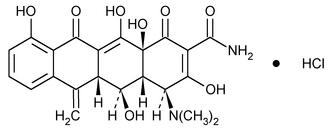Methacycline Hydrochloride
(meth'' a sye' kleen hye'' droe klor' ide).
2-Naphthacenecarboxamide, 4-(dimethylamino)-1,4,4a,5,5a,6,11,lum12a-octahydro-3,5,10,12,12a-pentahydroxy-6-methylene-1,11-dioxo-, monohydrochloride, [4S-(4
4-(Dimethylamino)-1,4,4a,5,5a,6,11,12a-octahydro-3,5,10,12,12a-pentahydroxy-6-methylene-1,11-dioxo-2-naphthacenecarboxamide monohydrochloride
» Methacycline Hydrochloride has a potency equivalent to not less than 832 µg and not more than 970 µg of methacycline (C22H22N2O8) per mg.
Packaging and storage—
Preserve in tight, light-resistant containers.
Identification, Ultraviolet Absorption  197U
197U —
—
Solution:
20 µg per mL.
Medium:
hydrochloric acid in methanol (1 in 1200).
Absorptivity at 345 nm, calculated on the dried basis, is between 88.4% and 96.4% of the USP Methacycline Hydrochloride RS, the potency of the Reference Standard being taken into account.
Crystallinity  695
695 :
meets the requirements.
:
meets the requirements.
pH  791
791 :
between 2.0 and 3.0, in a solution containing 10 mg of methacycline per mL.
:
between 2.0 and 3.0, in a solution containing 10 mg of methacycline per mL.
Water, Method I  921
921 :
not more than 2.0%.
:
not more than 2.0%.
Assay—
Mobile phase—
Prepare a mixture of 0.2 M ammonium oxalate, dimethylformamide, and 0.1 M edetate disodium (11:5:4), adjust with tetrabutylammonium hydroxide, 40 percent in water, to a pH of 7.0, and filter. Make adjustments, if necessary (see System Suitability under Chromatography  621
621 ).
).
System suitability preparation—
Prepare a solution of USP Methacycline Hydrochloride RS and USP Doxycycline Hyclate RS in Mobile phase containing about 0.5 mg of each per mL.
Standard preparation—
Quantitatively dissolve an accurately weighed quantity of USP Methacycline Hydrochloride RS in Mobile phase to obtain a solution having a known concentration of about 0.5 mg per mL.
Assay preparation—
Transfer about 50 mg of Methacycline Hydrochloride, accurately weighed, to a 100-mL volumetric flask, dilute with Mobile phase to volume, and mix.
Chromatographic system (see Chromatography  621
621 )—
The liquid chromatograph is equipped with a 354-nm detector and a 4.6-mm × 15-cm column that contains 3.5-µm packing L1. The flow rate is about 1 mL per minute. Chromatograph the System suitability preparation, and record the peak responses as directed for Procedure: the relative retention times are about 0.75 for methacycline and 1.0 for doxycycline; and the resolution, R, between methacycline and doxycycline is not less than 1.5. Chromatograph the Standard preparation, and record the peak responses as directed for Procedure: the tailing factor is not more than 1.5; and the relative standard deviation for replicate injections is not more than 1.0%.
)—
The liquid chromatograph is equipped with a 354-nm detector and a 4.6-mm × 15-cm column that contains 3.5-µm packing L1. The flow rate is about 1 mL per minute. Chromatograph the System suitability preparation, and record the peak responses as directed for Procedure: the relative retention times are about 0.75 for methacycline and 1.0 for doxycycline; and the resolution, R, between methacycline and doxycycline is not less than 1.5. Chromatograph the Standard preparation, and record the peak responses as directed for Procedure: the tailing factor is not more than 1.5; and the relative standard deviation for replicate injections is not more than 1.0%.
Procedure—
Separately inject equal volumes (about 20 µL) of the Standard preparation and the Assay preparation into the chromatograph, record the chromatograms, and measure the areas for the major peaks. Calculate the quantity, in µg, of methacycline (C22H22N2O8) in each mg of Methacycline Hydrochloride taken by the formula:
100(CE / W)(rU / rS)
in which C is the concentration, in mg per mL, of USP Methacycline Hydrochloride RS in the Standard preparation; E is the methacycline content, in µg per mg, of USP Methacycline Hydrochloride RS; W is the quantity, in mg, of Methacycline Hydrochloride taken to prepare the Assay preparation; and rU and rS are the methacycline peak areas obtained from the Assay preparation and the Standard preparation, respectively.
Auxiliary Information—
Please check for your question in the FAQs before contacting USP.
| Topic/Question | Contact | Expert Committee |
|---|---|---|
| Monograph | Ahalya Wise, M.S.
Senior Scientific Liaison 1-301-816-8161 |
(SM12010) Monographs - Small Molecules 1 |
| Reference Standards | RS Technical Services 1-301-816-8129 rstech@usp.org |
USP35–NF30 Page 3838

